Indo-Canadian Relations: A Comprehensive Analysis from 1950 Onwards
VerifiedAdded on 2023/01/17
|6
|1575
|81
Project
AI Summary
This project provides a detailed analysis of Indo-Canadian relations from 1950 to the present day. It explores the historical context, including the influence of the British Empire and the Commonwealth, as well as the early settlement of Indo-Canadians in the 19th century. The project examines key events, such as the impact of Jawaharlal Nehru and Canadian politicians, the Suez Crisis, the Korean War, and Canada's aid to India. It also addresses significant challenges like India's nuclear tests and the Komagata Maru incident, along with the evolution of trade, security, and air connectivity between the two countries. The project highlights the importance of the Indo-Canadian Chamber of Commerce, the 'Year of India in Canada' in 2011, and the recent visits by political leaders to strengthen ties. The essay concludes by emphasizing the importance of continued cooperation between the two countries in various fields, including security and trade, and the need to remove obstacles to trade. The project references multiple sources to support its claims.
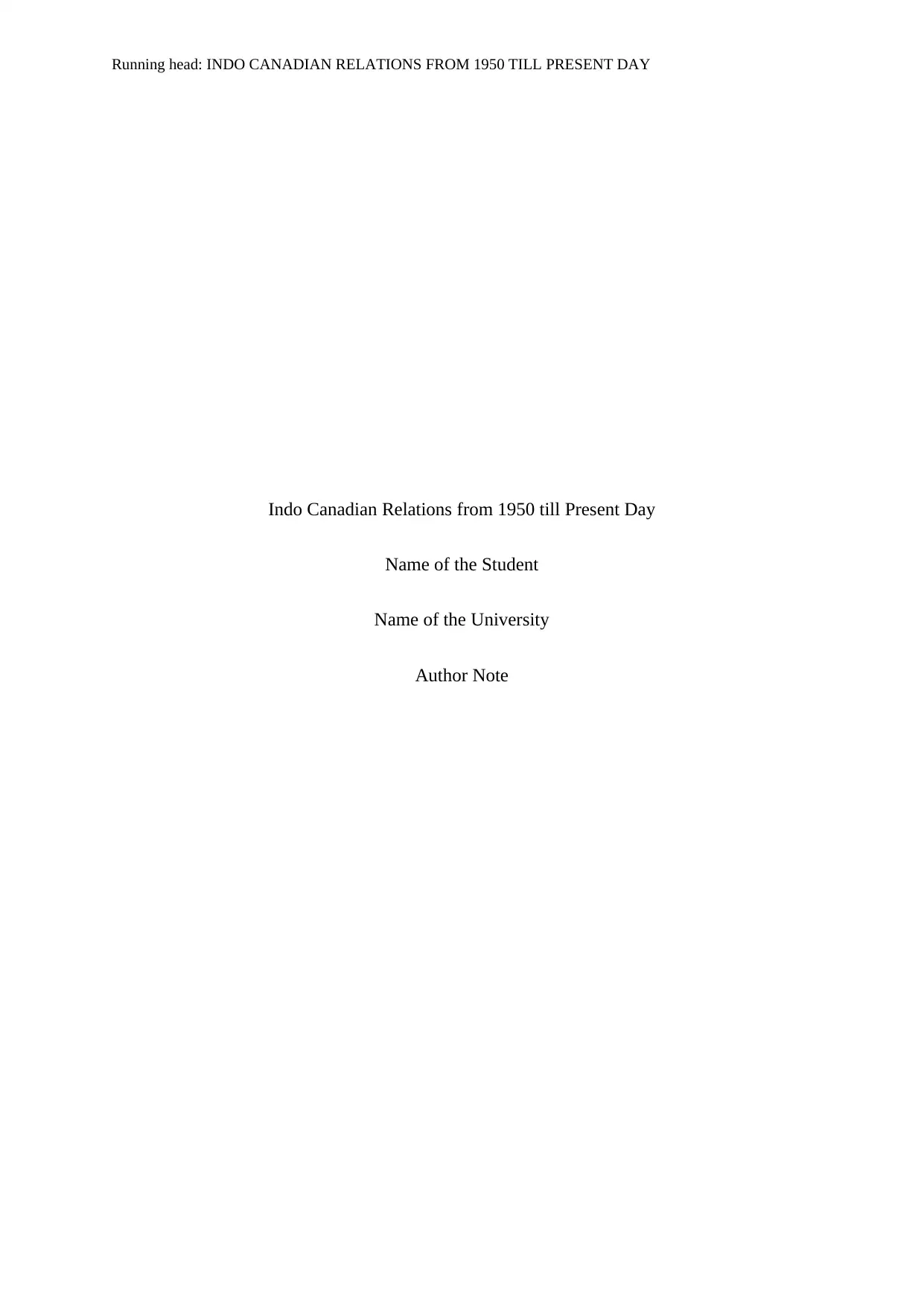
Running head: INDO CANADIAN RELATIONS FROM 1950 TILL PRESENT DAY
Indo Canadian Relations from 1950 till Present Day
Name of the Student
Name of the University
Author Note
Indo Canadian Relations from 1950 till Present Day
Name of the Student
Name of the University
Author Note
Paraphrase This Document
Need a fresh take? Get an instant paraphrase of this document with our AI Paraphraser
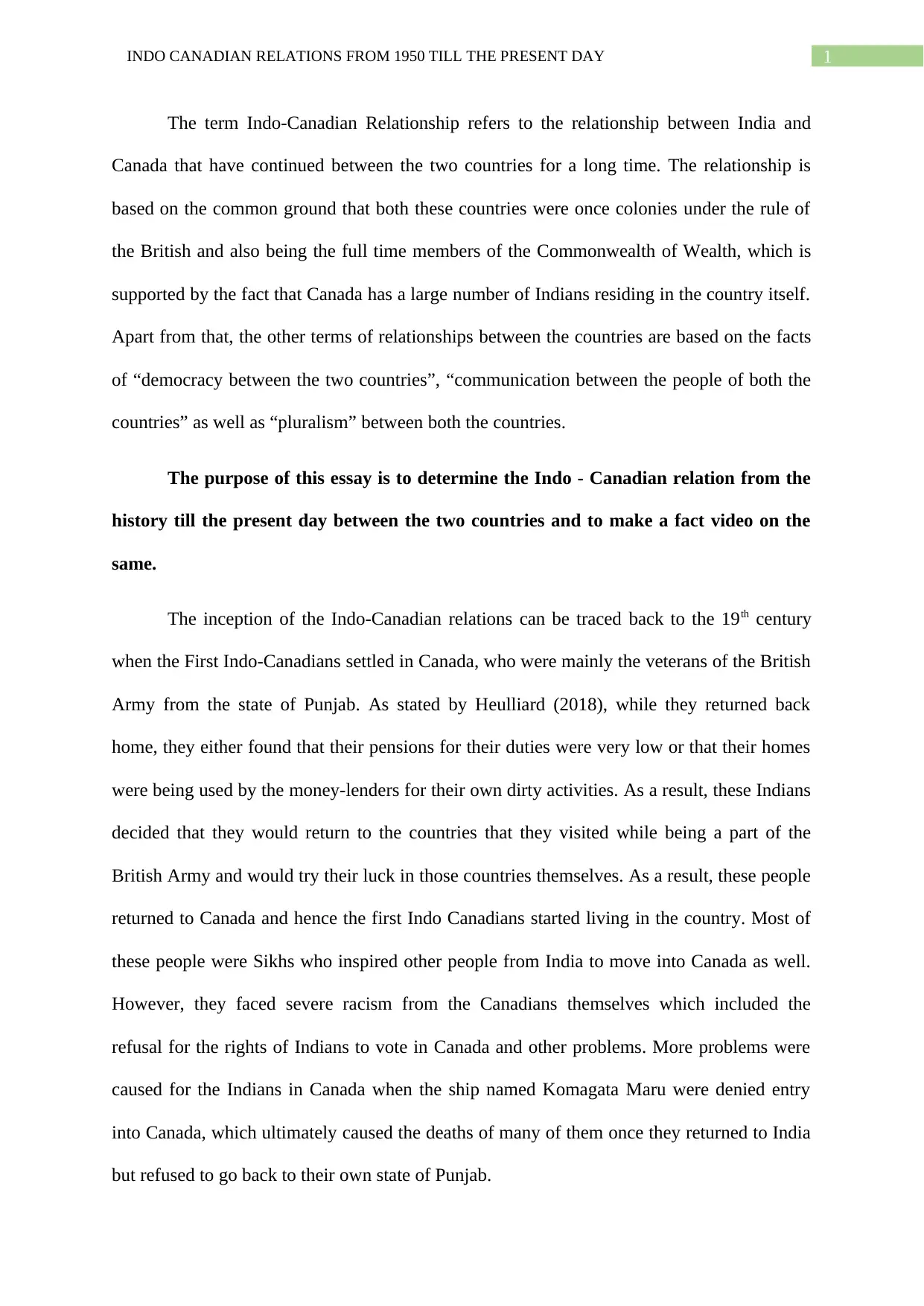
1INDO CANADIAN RELATIONS FROM 1950 TILL THE PRESENT DAY
The term Indo-Canadian Relationship refers to the relationship between India and
Canada that have continued between the two countries for a long time. The relationship is
based on the common ground that both these countries were once colonies under the rule of
the British and also being the full time members of the Commonwealth of Wealth, which is
supported by the fact that Canada has a large number of Indians residing in the country itself.
Apart from that, the other terms of relationships between the countries are based on the facts
of “democracy between the two countries”, “communication between the people of both the
countries” as well as “pluralism” between both the countries.
The purpose of this essay is to determine the Indo - Canadian relation from the
history till the present day between the two countries and to make a fact video on the
same.
The inception of the Indo-Canadian relations can be traced back to the 19th century
when the First Indo-Canadians settled in Canada, who were mainly the veterans of the British
Army from the state of Punjab. As stated by Heulliard (2018), while they returned back
home, they either found that their pensions for their duties were very low or that their homes
were being used by the money-lenders for their own dirty activities. As a result, these Indians
decided that they would return to the countries that they visited while being a part of the
British Army and would try their luck in those countries themselves. As a result, these people
returned to Canada and hence the first Indo Canadians started living in the country. Most of
these people were Sikhs who inspired other people from India to move into Canada as well.
However, they faced severe racism from the Canadians themselves which included the
refusal for the rights of Indians to vote in Canada and other problems. More problems were
caused for the Indians in Canada when the ship named Komagata Maru were denied entry
into Canada, which ultimately caused the deaths of many of them once they returned to India
but refused to go back to their own state of Punjab.
The term Indo-Canadian Relationship refers to the relationship between India and
Canada that have continued between the two countries for a long time. The relationship is
based on the common ground that both these countries were once colonies under the rule of
the British and also being the full time members of the Commonwealth of Wealth, which is
supported by the fact that Canada has a large number of Indians residing in the country itself.
Apart from that, the other terms of relationships between the countries are based on the facts
of “democracy between the two countries”, “communication between the people of both the
countries” as well as “pluralism” between both the countries.
The purpose of this essay is to determine the Indo - Canadian relation from the
history till the present day between the two countries and to make a fact video on the
same.
The inception of the Indo-Canadian relations can be traced back to the 19th century
when the First Indo-Canadians settled in Canada, who were mainly the veterans of the British
Army from the state of Punjab. As stated by Heulliard (2018), while they returned back
home, they either found that their pensions for their duties were very low or that their homes
were being used by the money-lenders for their own dirty activities. As a result, these Indians
decided that they would return to the countries that they visited while being a part of the
British Army and would try their luck in those countries themselves. As a result, these people
returned to Canada and hence the first Indo Canadians started living in the country. Most of
these people were Sikhs who inspired other people from India to move into Canada as well.
However, they faced severe racism from the Canadians themselves which included the
refusal for the rights of Indians to vote in Canada and other problems. More problems were
caused for the Indians in Canada when the ship named Komagata Maru were denied entry
into Canada, which ultimately caused the deaths of many of them once they returned to India
but refused to go back to their own state of Punjab.
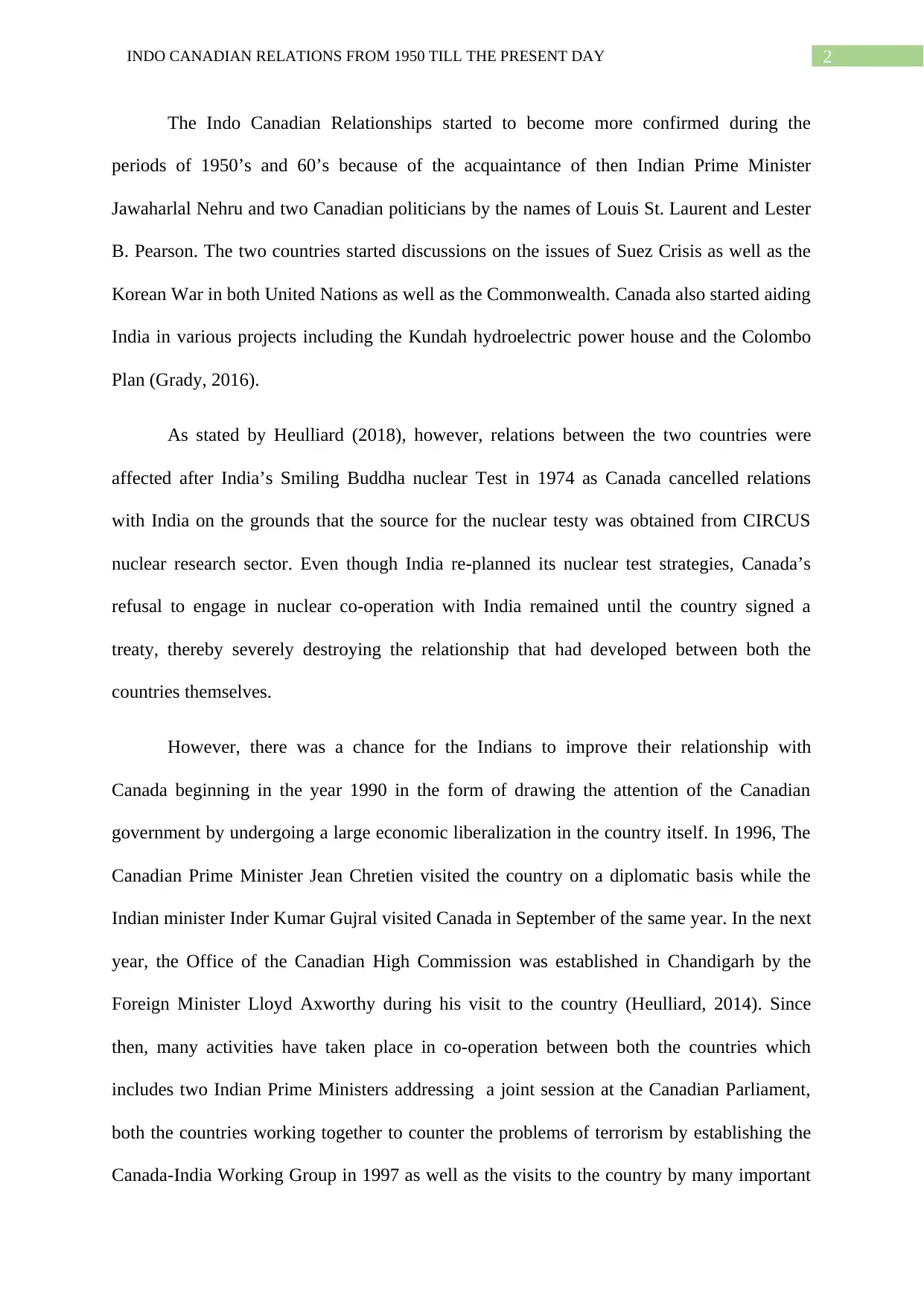
2INDO CANADIAN RELATIONS FROM 1950 TILL THE PRESENT DAY
The Indo Canadian Relationships started to become more confirmed during the
periods of 1950’s and 60’s because of the acquaintance of then Indian Prime Minister
Jawaharlal Nehru and two Canadian politicians by the names of Louis St. Laurent and Lester
B. Pearson. The two countries started discussions on the issues of Suez Crisis as well as the
Korean War in both United Nations as well as the Commonwealth. Canada also started aiding
India in various projects including the Kundah hydroelectric power house and the Colombo
Plan (Grady, 2016).
As stated by Heulliard (2018), however, relations between the two countries were
affected after India’s Smiling Buddha nuclear Test in 1974 as Canada cancelled relations
with India on the grounds that the source for the nuclear testy was obtained from CIRCUS
nuclear research sector. Even though India re-planned its nuclear test strategies, Canada’s
refusal to engage in nuclear co-operation with India remained until the country signed a
treaty, thereby severely destroying the relationship that had developed between both the
countries themselves.
However, there was a chance for the Indians to improve their relationship with
Canada beginning in the year 1990 in the form of drawing the attention of the Canadian
government by undergoing a large economic liberalization in the country itself. In 1996, The
Canadian Prime Minister Jean Chretien visited the country on a diplomatic basis while the
Indian minister Inder Kumar Gujral visited Canada in September of the same year. In the next
year, the Office of the Canadian High Commission was established in Chandigarh by the
Foreign Minister Lloyd Axworthy during his visit to the country (Heulliard, 2014). Since
then, many activities have taken place in co-operation between both the countries which
includes two Indian Prime Ministers addressing a joint session at the Canadian Parliament,
both the countries working together to counter the problems of terrorism by establishing the
Canada-India Working Group in 1997 as well as the visits to the country by many important
The Indo Canadian Relationships started to become more confirmed during the
periods of 1950’s and 60’s because of the acquaintance of then Indian Prime Minister
Jawaharlal Nehru and two Canadian politicians by the names of Louis St. Laurent and Lester
B. Pearson. The two countries started discussions on the issues of Suez Crisis as well as the
Korean War in both United Nations as well as the Commonwealth. Canada also started aiding
India in various projects including the Kundah hydroelectric power house and the Colombo
Plan (Grady, 2016).
As stated by Heulliard (2018), however, relations between the two countries were
affected after India’s Smiling Buddha nuclear Test in 1974 as Canada cancelled relations
with India on the grounds that the source for the nuclear testy was obtained from CIRCUS
nuclear research sector. Even though India re-planned its nuclear test strategies, Canada’s
refusal to engage in nuclear co-operation with India remained until the country signed a
treaty, thereby severely destroying the relationship that had developed between both the
countries themselves.
However, there was a chance for the Indians to improve their relationship with
Canada beginning in the year 1990 in the form of drawing the attention of the Canadian
government by undergoing a large economic liberalization in the country itself. In 1996, The
Canadian Prime Minister Jean Chretien visited the country on a diplomatic basis while the
Indian minister Inder Kumar Gujral visited Canada in September of the same year. In the next
year, the Office of the Canadian High Commission was established in Chandigarh by the
Foreign Minister Lloyd Axworthy during his visit to the country (Heulliard, 2014). Since
then, many activities have taken place in co-operation between both the countries which
includes two Indian Prime Ministers addressing a joint session at the Canadian Parliament,
both the countries working together to counter the problems of terrorism by establishing the
Canada-India Working Group in 1997 as well as the visits to the country by many important
⊘ This is a preview!⊘
Do you want full access?
Subscribe today to unlock all pages.

Trusted by 1+ million students worldwide
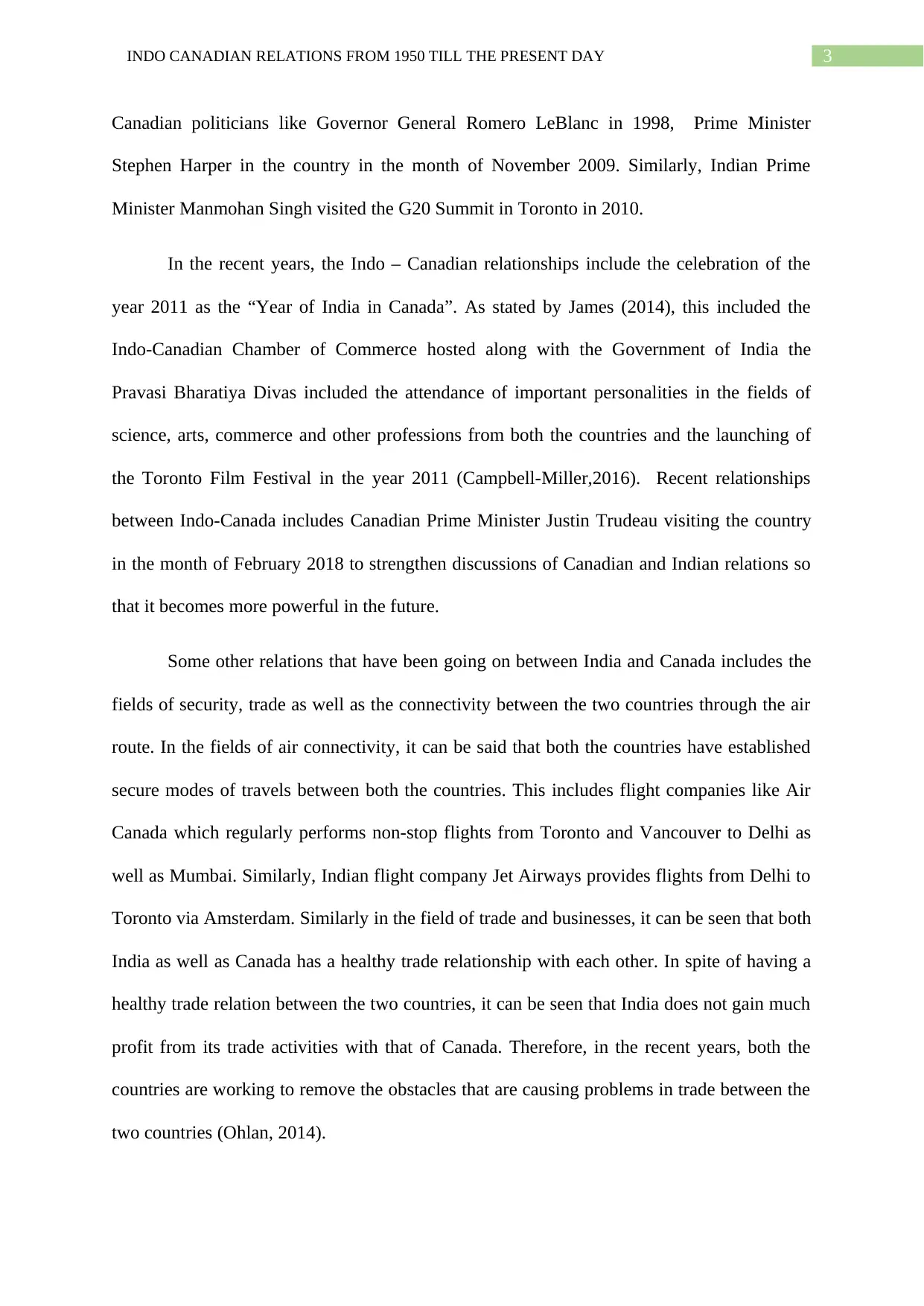
3INDO CANADIAN RELATIONS FROM 1950 TILL THE PRESENT DAY
Canadian politicians like Governor General Romero LeBlanc in 1998, Prime Minister
Stephen Harper in the country in the month of November 2009. Similarly, Indian Prime
Minister Manmohan Singh visited the G20 Summit in Toronto in 2010.
In the recent years, the Indo – Canadian relationships include the celebration of the
year 2011 as the “Year of India in Canada”. As stated by James (2014), this included the
Indo-Canadian Chamber of Commerce hosted along with the Government of India the
Pravasi Bharatiya Divas included the attendance of important personalities in the fields of
science, arts, commerce and other professions from both the countries and the launching of
the Toronto Film Festival in the year 2011 (Campbell-Miller,2016). Recent relationships
between Indo-Canada includes Canadian Prime Minister Justin Trudeau visiting the country
in the month of February 2018 to strengthen discussions of Canadian and Indian relations so
that it becomes more powerful in the future.
Some other relations that have been going on between India and Canada includes the
fields of security, trade as well as the connectivity between the two countries through the air
route. In the fields of air connectivity, it can be said that both the countries have established
secure modes of travels between both the countries. This includes flight companies like Air
Canada which regularly performs non-stop flights from Toronto and Vancouver to Delhi as
well as Mumbai. Similarly, Indian flight company Jet Airways provides flights from Delhi to
Toronto via Amsterdam. Similarly in the field of trade and businesses, it can be seen that both
India as well as Canada has a healthy trade relationship with each other. In spite of having a
healthy trade relation between the two countries, it can be seen that India does not gain much
profit from its trade activities with that of Canada. Therefore, in the recent years, both the
countries are working to remove the obstacles that are causing problems in trade between the
two countries (Ohlan, 2014).
Canadian politicians like Governor General Romero LeBlanc in 1998, Prime Minister
Stephen Harper in the country in the month of November 2009. Similarly, Indian Prime
Minister Manmohan Singh visited the G20 Summit in Toronto in 2010.
In the recent years, the Indo – Canadian relationships include the celebration of the
year 2011 as the “Year of India in Canada”. As stated by James (2014), this included the
Indo-Canadian Chamber of Commerce hosted along with the Government of India the
Pravasi Bharatiya Divas included the attendance of important personalities in the fields of
science, arts, commerce and other professions from both the countries and the launching of
the Toronto Film Festival in the year 2011 (Campbell-Miller,2016). Recent relationships
between Indo-Canada includes Canadian Prime Minister Justin Trudeau visiting the country
in the month of February 2018 to strengthen discussions of Canadian and Indian relations so
that it becomes more powerful in the future.
Some other relations that have been going on between India and Canada includes the
fields of security, trade as well as the connectivity between the two countries through the air
route. In the fields of air connectivity, it can be said that both the countries have established
secure modes of travels between both the countries. This includes flight companies like Air
Canada which regularly performs non-stop flights from Toronto and Vancouver to Delhi as
well as Mumbai. Similarly, Indian flight company Jet Airways provides flights from Delhi to
Toronto via Amsterdam. Similarly in the field of trade and businesses, it can be seen that both
India as well as Canada has a healthy trade relationship with each other. In spite of having a
healthy trade relation between the two countries, it can be seen that India does not gain much
profit from its trade activities with that of Canada. Therefore, in the recent years, both the
countries are working to remove the obstacles that are causing problems in trade between the
two countries (Ohlan, 2014).
Paraphrase This Document
Need a fresh take? Get an instant paraphrase of this document with our AI Paraphraser
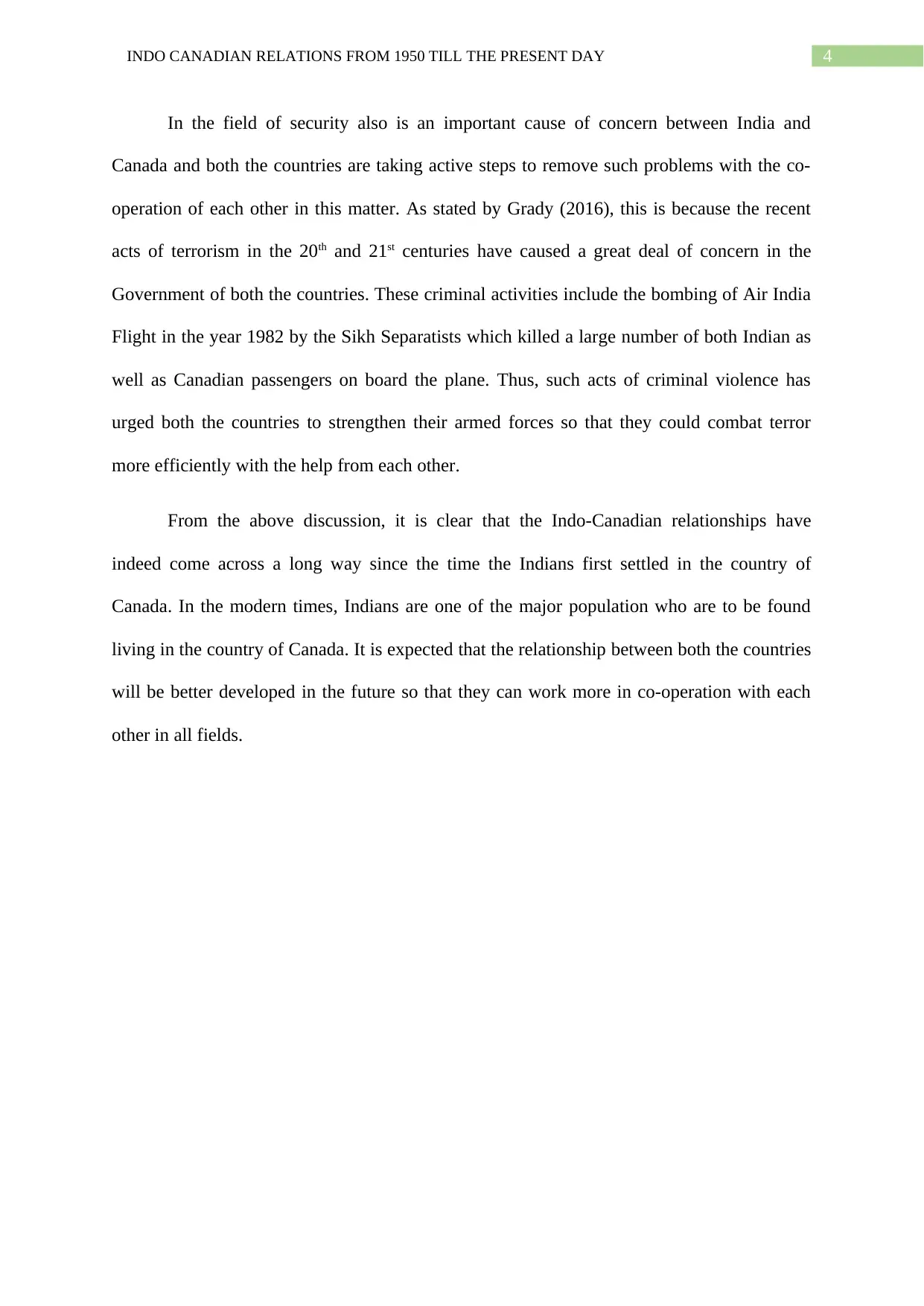
4INDO CANADIAN RELATIONS FROM 1950 TILL THE PRESENT DAY
In the field of security also is an important cause of concern between India and
Canada and both the countries are taking active steps to remove such problems with the co-
operation of each other in this matter. As stated by Grady (2016), this is because the recent
acts of terrorism in the 20th and 21st centuries have caused a great deal of concern in the
Government of both the countries. These criminal activities include the bombing of Air India
Flight in the year 1982 by the Sikh Separatists which killed a large number of both Indian as
well as Canadian passengers on board the plane. Thus, such acts of criminal violence has
urged both the countries to strengthen their armed forces so that they could combat terror
more efficiently with the help from each other.
From the above discussion, it is clear that the Indo-Canadian relationships have
indeed come across a long way since the time the Indians first settled in the country of
Canada. In the modern times, Indians are one of the major population who are to be found
living in the country of Canada. It is expected that the relationship between both the countries
will be better developed in the future so that they can work more in co-operation with each
other in all fields.
In the field of security also is an important cause of concern between India and
Canada and both the countries are taking active steps to remove such problems with the co-
operation of each other in this matter. As stated by Grady (2016), this is because the recent
acts of terrorism in the 20th and 21st centuries have caused a great deal of concern in the
Government of both the countries. These criminal activities include the bombing of Air India
Flight in the year 1982 by the Sikh Separatists which killed a large number of both Indian as
well as Canadian passengers on board the plane. Thus, such acts of criminal violence has
urged both the countries to strengthen their armed forces so that they could combat terror
more efficiently with the help from each other.
From the above discussion, it is clear that the Indo-Canadian relationships have
indeed come across a long way since the time the Indians first settled in the country of
Canada. In the modern times, Indians are one of the major population who are to be found
living in the country of Canada. It is expected that the relationship between both the countries
will be better developed in the future so that they can work more in co-operation with each
other in all fields.
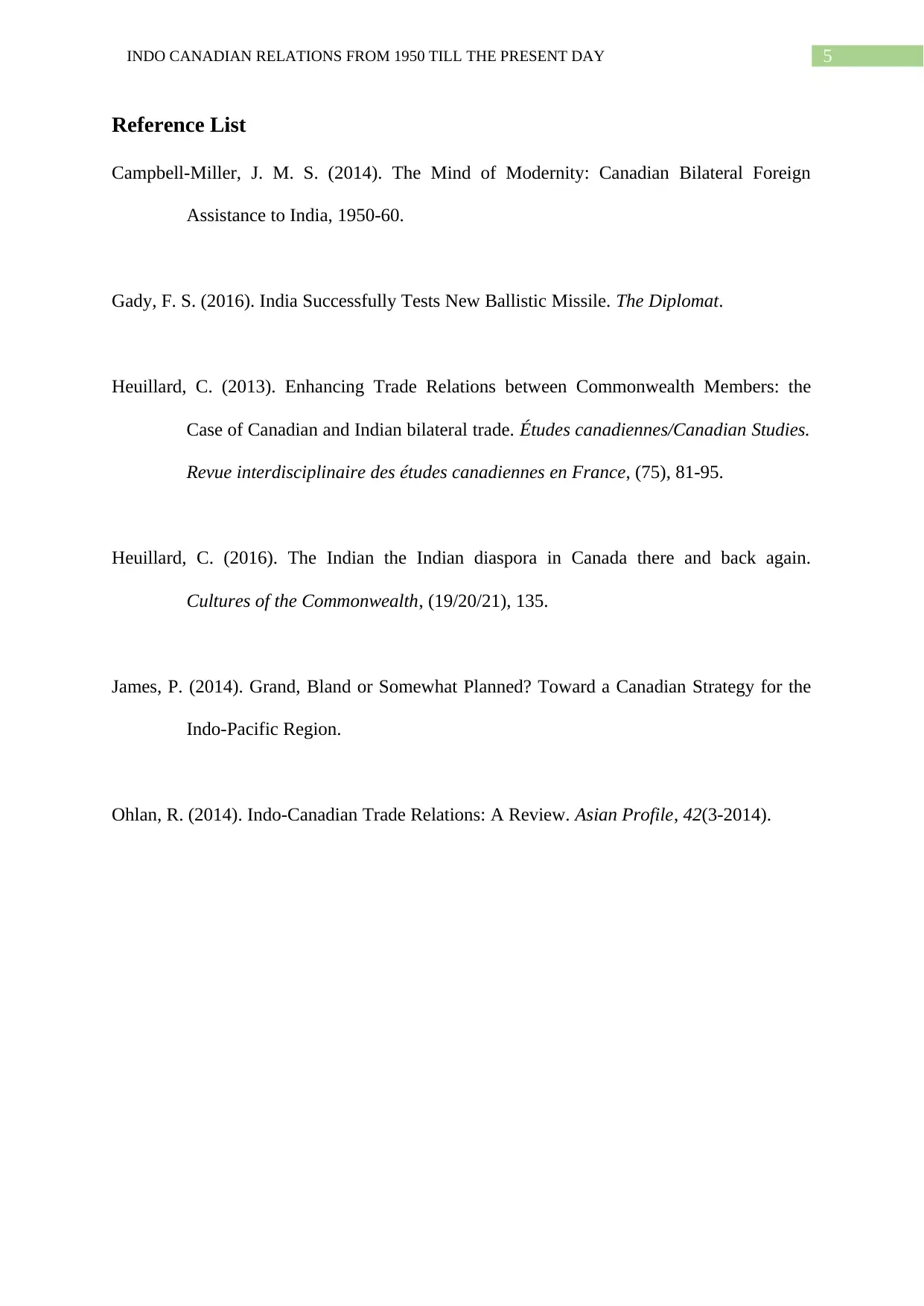
5INDO CANADIAN RELATIONS FROM 1950 TILL THE PRESENT DAY
Reference List
Campbell-Miller, J. M. S. (2014). The Mind of Modernity: Canadian Bilateral Foreign
Assistance to India, 1950-60.
Gady, F. S. (2016). India Successfully Tests New Ballistic Missile. The Diplomat.
Heuillard, C. (2013). Enhancing Trade Relations between Commonwealth Members: the
Case of Canadian and Indian bilateral trade. Études canadiennes/Canadian Studies.
Revue interdisciplinaire des études canadiennes en France, (75), 81-95.
Heuillard, C. (2016). The Indian the Indian diaspora in Canada there and back again.
Cultures of the Commonwealth, (19/20/21), 135.
James, P. (2014). Grand, Bland or Somewhat Planned? Toward a Canadian Strategy for the
Indo-Pacific Region.
Ohlan, R. (2014). Indo-Canadian Trade Relations: A Review. Asian Profile, 42(3-2014).
Reference List
Campbell-Miller, J. M. S. (2014). The Mind of Modernity: Canadian Bilateral Foreign
Assistance to India, 1950-60.
Gady, F. S. (2016). India Successfully Tests New Ballistic Missile. The Diplomat.
Heuillard, C. (2013). Enhancing Trade Relations between Commonwealth Members: the
Case of Canadian and Indian bilateral trade. Études canadiennes/Canadian Studies.
Revue interdisciplinaire des études canadiennes en France, (75), 81-95.
Heuillard, C. (2016). The Indian the Indian diaspora in Canada there and back again.
Cultures of the Commonwealth, (19/20/21), 135.
James, P. (2014). Grand, Bland or Somewhat Planned? Toward a Canadian Strategy for the
Indo-Pacific Region.
Ohlan, R. (2014). Indo-Canadian Trade Relations: A Review. Asian Profile, 42(3-2014).
⊘ This is a preview!⊘
Do you want full access?
Subscribe today to unlock all pages.

Trusted by 1+ million students worldwide
1 out of 6
Related Documents
Your All-in-One AI-Powered Toolkit for Academic Success.
+13062052269
info@desklib.com
Available 24*7 on WhatsApp / Email
![[object Object]](/_next/static/media/star-bottom.7253800d.svg)
Unlock your academic potential
Copyright © 2020–2025 A2Z Services. All Rights Reserved. Developed and managed by ZUCOL.




